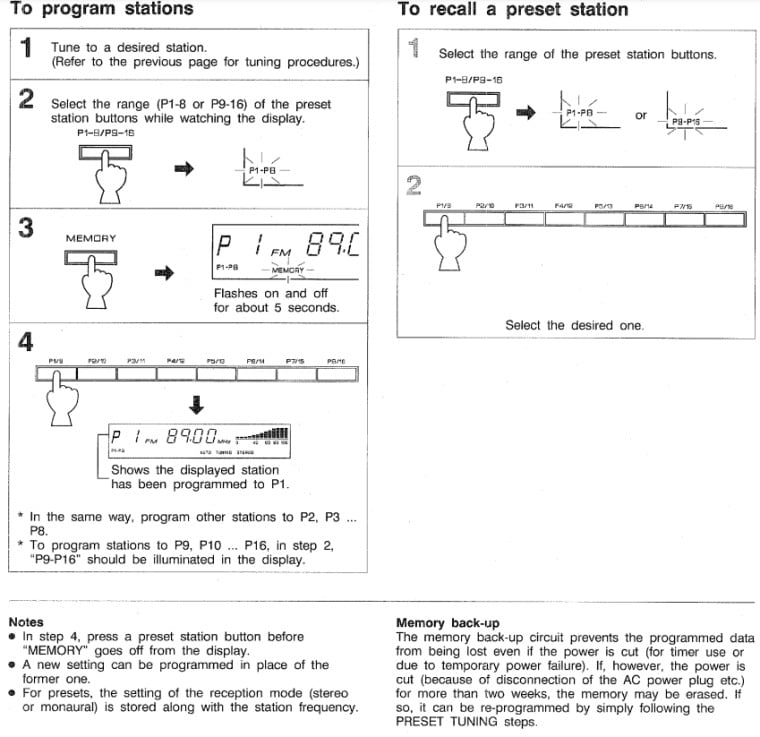
The Yamaha RX-450 receiver isn’t the silver faced, wood encased stereo that most people think of when they think vintage receivers. But, introduced in 1990, it really is a borderline vintage receiver now. It also represents audio manufacturers move toward more mass market receivers. The “Natural Sound” which Yamaha used as part of the brand name is seen by some as just a marketing slogan but Yamaha implied that their circuitry kept the output signal as close to the input signal as possible.
The RX-450 was an entry level unit but still produced 45 watts per channel. It has a nice LED display for tuning as well as a signal strength meter just to the right of the station display.

Tuning the RX-450 can be done in automatic or manual mode. Here’s how:

The RX-450 has up to 16 station presets. Here’s how to set the presets:

The RX-450 (not to be confused with the RX-V450 which is an AV receiver) can handle two sets of speakers from 4 to 8 ohms. It has a Loudness control as well as Treble and Bass controls. The Loudness control compensates for the human ear’s loss of sensitivity at the low and high frequencies at low volume. The way it works is you set the Loudness to Flat and then set the Volume to the loudest listening level that you would listen to. Then turn the Loudness control counter clockwise until the volume level is where you’d like it.
The Bass Extension button just boosts the bass frequency response when in the “On” position. The CD Direct button outputs the CD signal directly without routing it through the Balance or Loudness circuits. Therefore the output signal from the CD is less muddied by those circuits.

One distinct advantage of the Yamaha RX-450 is that it has inputs for Phono, Tape and CD. It even has a Video/Aux input which is a line level input. So, you can run a turntable, a reel-to-reel, a cassette deck or even an equalizer through RX-450. The RCX Remote Control Transmitter makes it convenient to control as well.

Specifications:
- Tuning range: FM, MW
- Power output: 45 watts per channel into 8 ohms (stereo)
- Frequency response: 20Hz to 20kHz
- Total harmonic distortion: 0.04%
- Input sensitivity: 2.5mV (MM), 150mV (line)
- Damping factor: 50
- Signal to noise ratio: 87dB (MM), 103dB (line)
- Channel separation: 55dB (MM), 52dB (line)
- Output: 150mV (line)
- Speaker load impedance: 8 ohms (minimum)
- Dimensions: 17.1 X 5.2 X 11.5 inches (435 x 131 x 291.5mm)
- Weight: 12.5 lbs. (5.7kg)
- Accessories: remote control
- Year: 1990
Many of the Yamaha RX-450’s were made in Japan though I’ve seen some that were made in Malaysia or Singapore.

Overall the Yamaha RX-450 is a nice little receiver. 45 watts per channel should be enough for most users and the assortment of inputs and outputs as well as channel presets and a remote control make it very versatile and convenient.


I had this amp after I got out of college. For a solid-state design, it sounds great, especially the “natural sound” where it touches as little as possible going to amplification. I play music and have spent many an hour in recording studios on very expensive systems and for the price, this amp running in natural mode sounds very true to the recorded sound with little coloring. Extremely flat, which is what I like… assuming you have decent speakers.
My very first receiver. Bought it when I was 20. Upgraded from a Fisher system back in 1989. This piece lasted til about til the early 2000s. Couldn’t find anyone to fix it so I trashed it. Wish I would have kept it. Very high quality sound with my basic set up of Kenwood CD players and Technics cassette decks and Bose 301 speakers.
I bought my RX450 back in 1990 still going strong today, I have upgraded it with a wxad 10 Music cast unit for streaming spotify and i use it everyday .
A salute to Yamahas build quality
I have one of these running my Klipsch Cornwall IVs. I really like the bass extension button. Really fills out the bass in my living room at low volumes. I think this reciever is nicer than most under $1000 today.